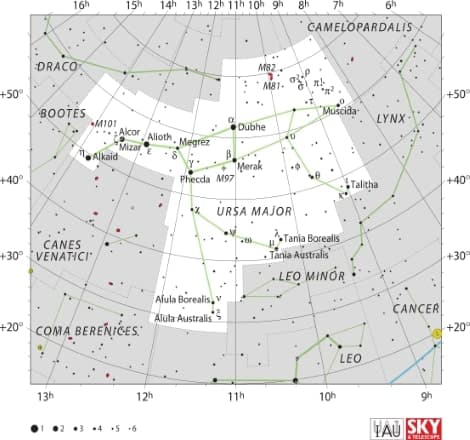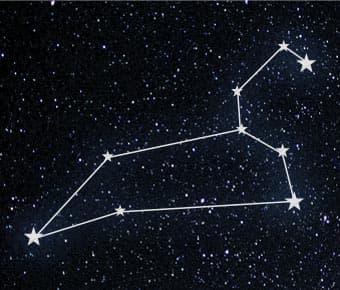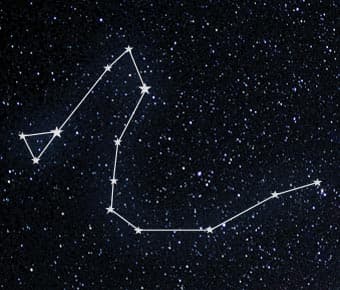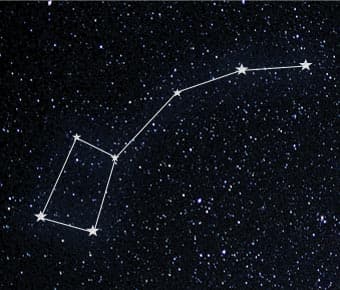You may know the big dipper from your recent trip to Alton Towers or any other theme park, but do you know about the big dipper in the sky?
It is located in one of the most interesting constellations called Ursa Major. You can learn lots about the huge Ursa Major constellation in this friendly guide.
The Mythology Behind Ursa Major
Ursa Major features in lots of cultures and the majority of them make connections to a bear image. One of the most famous comes from Greek mythology. In this myth, Callisto had sworn his love exclusively to Artemis. However, Zeus fell in love with Callisto and they had a son named Arcas. Zeus’s wife, Hera, was furious that she had been deceived by the pair and turned Callisto into a bear.
The bear wandered the forest for years trying to escape hunters. The bear then bumped into her son, Arcas, in the forest and made him scared. So, he drew his spear ready for battle. But Zeus was watching the events unfold and sent a whirlwind to prevent the mother and son – unknowingly – from fighting. Zeus sent both of them to the sky where they were to become constellations. Callisto the bear became Ursa Major and Arcas was made into Boötes, although some suggest Arcas is Ursa Minor.
A slightly different version of this myth suggests that it was not Hera but Artemis who turned Callisto into the bear. Furthermore, the bear and Arcas went on the run but were captured. Zeus saved them by placing them in the sky as constellations to keep them protected.

Source: Wikipedia
- Symbolism: the Great Bear
- Right ascension: 10.67h
- Declination: +55.38°
- Area: 1280 sq. deg. (3rd)
- Main stars: 7, 20
- Bayer/Flamsteed stars: 93
- Stars with planets:21
- Brightest star: (Alioth) (1.76m)
The Ursa major Star The Ursa Major Big Dipper and Appearance
If you have ever seen the big dipper in the sky, then you have already seen part of the Ursa Major constellation. The big dipper is a collection of Ursa Major’s brightest stars which take the form of a recognisable asterism, i.e. a shape that most people recognise who are not frequent stargazers. Note, the big dipper is part of the Ursa Major constellation, but it is not the whole constellation. The constellation is often said to look like a bear when the stars are joined up in a particular order. You will need to use your imagination to see the bear in all its glory, but nevertheless, looking for Ursa Major is even more fun because of its big dipper.
A comprehensive guide to the arrangement or Ursa Major’s stars can be found on this Ursa Major guide!
Which Is the Brightest Star in Ursa Major?
The brightest star of Ursa Major is called Alioth. It is the 31st brightest star we can see from Earth and it is relatively close to us at just 81 light years away. This is still very far, but many other constellation stars are over 200 light years away. The brightest stars are not always the closest stars to Earth. Alioth is one of the seven stars that form the big dipper asterism. The other six stars are:
- Dubhe
- Merak
- Phecda
- Megrez
- Mizar
- Alkaid
Where Is the Ursa Major Constellation?
Ursa Major is the third biggest constellation and covers 1280 square degrees. It is situated in the Northern Hemisphere’s second quadrant (NQ2), making it visible between latitudes of +90 and -30 degrees.
There are many other star constellations close to Ursa Major. These are Draco, Leo and Leo Minor, Camelopardalis, Canes Venatici and Boötes which is argued by some people to be a representation of the bear’s son, Arcas.
Can I See Ursa Major All Year from the UK?
Yes – the Ursa Major constellation is visible across most of the Northern Hemisphere for the entire year. Some of the constellation can be viewed from the Southern Hemisphere but the big dipper cannot be seen from the likes of Australia.
Despite Ursa Major sitting in the UK skies for the whole year, there is still a better time to go looking. It is recommended to search for Ursa Major in April at 9pm. But if you missed it in April, don’t let this stop you for searching for Ursa Major at any other time in the UK.
Distance to the Ursa Major Star Constellation
We cannot say the exact distance between Earth and the Ursa Major constellation because there is not one measurement. All the stars in Ursa Major are different distances away, so the constellation is closer and further away from Earth at different points. However, many of Ursa Major’s main stars are much closer to each other than most other constellation stars.
A good example is by looking at some stars from the big dipper. Earlier we told you that Alioth is 81 light years from us. Merak is very close to Alioth around 80 light years away– and so are some of the other big dipper stars - but Dubhe is much further away from Earth; it is over 100 light years away.
More Awesome Facts about Ursa Major
There is a really cool fact how the big dipper of Ursa Major was the subject of a well-known folk song and even guided slaves to freedom. Learn this interesting big dipper information and more cool Ursa Major facts below:
- There is slightly more to the myth told above. Hera was furious that Zeus had protected the bear that she persuaded Tethys and Oceanus to prevent the bear from breathing in northern waters. And this is said to be why Ursa Major in mid-northern latitudes does not set below the horizon.
- Many cultures and ancient people considered Ursa Major to be a bear – but not all of them. Other cultures saw sharks, skunks, camels and other animals in Ursa Major’s place.
- Slaves of America would use the Ursa Major constellation to help them find freedom. The big dipper, also known as the Drinking Gourd which had its own folk song, would guide them to freedom. For more information, learn about The Underground Railroad and the North Star to Freedom.
For more cool constellation guides, check back in with us at Star Name Registry soon.






